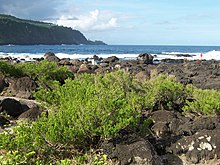| Pemphis | |
|---|---|

| |
| Pemphis acidula, in its shortest form, on the coast of Réunion Island | |
|
Scientific classification
| |
| Kingdom: | Plantae |
| Clade: | Tracheophytes |
| Clade: | Angiosperms |
| Clade: | Eudicots |
| Clade: | Rosids |
| Order: | Myrtales |
| Family: | Lythraceae |
| Subfamily: | Lythroideae |
| Genus: |
Pemphis J.R.Forst & G.Forst [1] |
Pemphis is a genus of maritime plants in family Lythraceae. It has only one species described in 1775, Pemphis acidula. [2] [3]

Pemphis are highly adaptive. Depending on environmental factors, they are densely branched, or low and spreading bushes or short trees, with main stems that can be furcated and lie nearly prone, or develop into one erect trunk. Leaves can be small, fleshy and succulent, or larger, flat and not fleshy. All surfaces are covered generally in silky, colorless trichomes. [4] The fruits and bee- pollinated flowers are produced throughout the year. Seeds can float, and are sometimes propagated through water dispersal. [5]
Habitat
Most Pemphis live either at the verges of mangrove forests, well away from the forest-ocean interface; or they colonize beaches behind the intertidal zone, taking hold on rocks, gravel or sand, laterite or limestone, and frequently on promontories or crags. [5]
Range and distribution
They are not common, but far ranging from coastal, eastern Africa (including the Seychelles, [6] and the Zanzibar Archipelago [5]), states with Indian Ocean coastlines, to the Pacific ( Philippines, [7] Cook Islands [8]), northwards up to Taiwan and the Ryukyu Islands [4] Other places reporting Pemphis include mainland coastal Tanzania, Thailand, Malaysia ( Johore), Singapore, Indonesia ( Papua, Sumatra, the Moluccas, Madura and Java), Papua New Guinea, Hong Kong and throughout tropical Australia. On Java in particular (where it is known as stigi or santigi), some areas are uncharacteristically abundant. [5]
Uses
Despite the difficulty presented for the prospective carver, wood from Pemphis species is highly prized for its extreme heaviness, toughness and resistance to warping. It is usually fashioned into walking canes, fence posts, tool handles, and even anchors, exhibiting a fine finish. [5]
Pemphis acidula is a valuable tropical species for bonsai, particularly in Asia. [9]
Species
This list is according to World Flora Online. [3]
- Pemphis acidula J.R.Forst. & G.Forst. (type) [2]
Former species include:
- Pemphis hexandra Mart. ex Koehne = Diplusodon hexander
- Pemphis madagascariensis (Baker) Koehne = Koehneria madagascariensis
- Pemphis stachydifolia Mart. ex Koehne = Diplusodon villosissimus
See also
References
- ^ "Plant name details for Pemphis". IPNI. Retrieved November 21, 2009.
- ^ a b Char. Gen. Pl. 34. 1775 "Plant Name Details for Pemphis acidula". IPNI. Retrieved November 21, 2009.
- ^ a b "Pemphis J.R.Forst. & G.Forst". World Flora Online. World Flora Consortium. 2013. Retrieved 2 September 2023.
- ^ a b Wu Zheng-yi; P. H. Raven, eds. (1994). "Pemphis". Flora of China (English edition). Retrieved November 21, 2009.
- ^ a b c d e Wim Giesen; Stephan Wulffraat; Max Zieren; Liesbeth Scholten (2006). "Part 2: Description - Trees & shrubs". Mangrove Guidebook for Southeast Asia. Bangkok, Thailand: FAO, Regional Office for Asia and the Pacific; Wetlands International. ISBN 974-7946-85-8. Retrieved November 21, 2009.
- ^ Piggott, C.J. (1961). "Notes on Some of the Seychelles Islands, Indian Ocean" (PDF). Atoll Research Bulletin. 83: 1–10. doi: 10.5479/si.00775630.83.1. Archived from the original (PDF) on 2006-09-13.
- ^ "Kabantigi". Herbarium Digital Library. Philippines National Herbarium. May 1, 2005. Retrieved November 21, 2009.
- ^ McCormack, Gerald (2007). "Pemphis acidula". Cook Islands Biodiversity Database. Vers. 2007.2. Bishop Museum, Rarotonga: Cook Islands National Heritage Trust. Retrieved November 21, 2009.
- ^ Cheng Cheng-Kung (2007). "Pemphis acidula — A Tropical Classic" (PDF). Bonsai Societies of Florida Magazine. XXXVIII, No. 4 (152 (Winter edition)). Cooper City, Florida: Bonsai Societies of Florida (BSF).